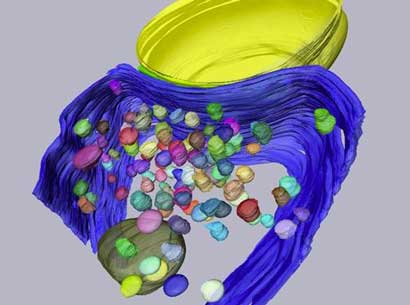June 13, 2017
A docking site per calcium channel cluster
Researchers at IST Austria find link between morphology and function of synapses | Study published in PNAS

In our brain, information is passed from one neuron to the next at a structure called synapse. At a chemical synapse, a chemical is released from the signal-sending neuron or presynaptic neuron. This neurotransmitter then crosses the synaptic cleft to bind to receptors in the target neuron or postsynaptic neuron. An extensive molecular machinery is at work: for example, vesicles filled with neurotransmitter dock at “docking sites” in the pre-synaptic active zone before they fuse and release the neurotransmitter into the synapse. A study co-led by Ryuichi Shigemoto, Professor at the Institute of Science and Technology Austria (IST Austria), with Alain Marty, Professor at Université Paris Descartes, uncovers that a single docking site may use a single cluster of calcium channels and that both the number of docking sites and the number of calcium clusters change in parallel with brain age. This establishes the first clear link between the morphology and function of docking sites. The study was published today in PNAS.
At a chemical synapse, signal transmission requires an elaborate sequence of events. It starts when an electrical signal, the action potential, reaches the synaptic terminal of the presynaptic neuron. This causes voltage-gated calcium channel to open. Calcium ions rapidly stream into the presynaptic terminal and the calcium concentration in the presynaptic terminal rises. This allows synaptic vesicles filled with neurotransmitter to fuse with the plasma membrane and release the neurotransmitters into the synaptic cleft. Speed is essential in information transmission. Therefore, before the action potential even arrives at the presynaptic terminal, vesicles containing neurotransmitter line up in a fusion-ready state at docking sites in the presynaptic terminal. When the action potential reaches the presynaptic terminal, the vesicles can rapidly fuse and release the neurotransmitter. Functionally, docking sites limit the maximum number of vesicles that can be released at each action potential, this determines the strength of the synapse. Until now, a clear link between the functional aspect of docking sites and their morphological aspect as sites where vesicles dock could not be established in the mammalian brain.
Shigemoto and colleagues used a high-resolution electron microscopy technique to look closely at the presynaptic terminal of a particular synapse in the mouse. They found that the number of functional docking sites matches the number of clusters of voltage-gated calcium channels in the presynaptic terminal. In addition, the number of docking sites and the number of calcium clusters change in parallel with brain age and synaptic size. This led the researchers to a major conclusion, as Shigemoto explains: “Based on our results, we suggest that for each docking site, there is a corresponding cluster of voltage-gated calcium channels. We propose a model in which each cluster of calcium channels is surrounded by enough free space to allow one synaptic vesicle to fuse in any direction.”
Ryuichi Shigemoto joined IST Austria as Professor in 2013. He and his group investigate the functional roles of ion channels and neurotransmitter receptors in neurons and glia using morphological, electrophysiological and molecular biological techniques. Shigemoto received an ERC Advanced Grant in 2016. Walter Kaufmann, Staff Scientist in IST Austria’s Electron Microscopy Facility, performed part of the research for the current study.



